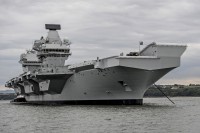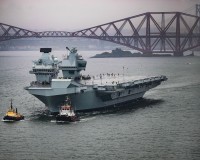Queen Elizabeth-class aircraft carrier
Basic information
Ship measurements
Machine
- 2 * Rolls-Royce Marine Trent MT30 36 MW (48,000 hp) gas turbine engine
- 4 * Wärtsilä 38 marine diesel engines (4 × 16V38 11.6 MW or 15,600 hp)
- 4 * GE Power Conversion 20 MW (27,000 hp) Advanced Induction Motors and VDM25000 Drives
- 2 * shafts; fixed pitch propellers
Personnel
Combat assets
- S1850M long range radar
- Type 997 Artisan 3D medium range radar
- Ultra Electronics Series 2500 Electro Optical System (EOS)
- Glide Path Camera (GPC)
- At least 3 * Phalanx CIWS
- 30-mm DS30M Mk2 guns
- Miniguns
- A Carrier Air Wing of 40 aircraft typically. Maximum load capacity is 72 aircraft:
- F-35B Lightning II
- Chinook
- Apache AH64
- Merlin HM2 and HC4
- Wildcat AH1 and HMA2
- Merlin Crowsnest AEW
The Queen Elizabeth class is a class of two aircraft carriers of the United Kingdom's Royal Navy. The lead ship, HMS Queen Elizabeth, was named on 4 July 2014, in honour of Elizabeth I (not Elizabeth II). She was commissioned on 7 December 2017. The second, HMS Prince of Wales, was launched on 21 December 2017, and was commissioned on 10 December 2019.
The vessels currently have a displacement of approximately 65,000 tonnes (64,000 long tons; 72,000 short tons), but the design anticipates added weight over the lifetime of the ships. The ships are 284 metres (932 ft) long and will have a Carrier Air Wing (CVW) of up to forty aircraft (though they are capable of carrying up to fifty at full load). They are the largest warships ever constructed for the Royal Navy. The projected cost of the programme is £6.2 billion.
Both carriers were completed as originally planned, in a Short Take-Off and Vertical Landing (STOVL) configuration, deploying the Lockheed Martin F-35B.
The ships' company is 679, rising to 1,600 when the air crew is added. In April 2015 a parliamentary reply stated that the average crew size would be 672. The ships have a displacement of 65,000 tonnes on delivery, but the design allows for this to reach over 70,000 tonnes as the ships are upgraded through their lifetime. They have an overall length of 280 metres (920 ft), a width at deck level of 70 metres (230 ft), a height of 56 metres (184 ft), a draught of 11 metres (36 ft), and a range of 10,000 nautical miles (12,000 mi; 19,000 km). The Ministry of Defence decided not to use nuclear propulsion due to its high cost, so Integrated Electric Propulsion was chosen whereby power is supplied by two Rolls-Royce Marine Trent MT30 36 MW (48,000 hp) gas turbine generator units and four Wärtsilä diesel generator sets (two 9 MW or 12,000 hp and two 11 MW or 15,000 hp). The Trents and diesels are the largest ever supplied to the Royal Navy, and together they feed the low-voltage electrical systems as well as four GE Power Conversion's 20 MW Advanced Induction Motor (arranged in tandem) electric propulsion motors that drive the twin fixed-pitch propellers.
Instead of a single island superstructure containing both the ships' navigation bridges and flying control (flyco) centres, the ships have these operations divided between two structures, with the forward island for navigation and the aft island for controlling flying operations. The primary reason for having twin islands was to space out the funnels, as the ships were designed with redundancy with «duplicated main and secondary machinery in two complexes with independent uptakes and downtakes in each of the two islands», while the alternative of consolidating all the exhaust trunkings would have reduced hangar space as well as increasing the vulnerability to flooding. There are also additional benefits to having separate islands rather than a single large island, such as easier construction, reduced wind turbulence, and freed up deck space. Using two structures provides separate mountings for the air surveillance radar (forward), which does not interfere with the medium range radar (aft); furthermore, visibility is improved for both navigation and landing operations.
Under the flight deck are a further nine decks. The hangar deck measures 155 by 33.5 metres (509 by 110 ft) with a height of 6.7 to 10 metres (22 to 33 ft), large enough to accommodate up to twenty fixed and rotary wing aircraft. To transfer aircraft from the hangar to the flight deck, the ships have two large lifts, each of which is capable of lifting two F-35-sized aircraft, or one C47 Chinook from the hangar to the flight deck in sixty seconds. The ships' only announced self-defence weapons are currently the Phalanx CIWS for airborne threats, with miniguns and 30 mm cannon to counter seaborne threats.
The ship's radars will be the BAE Systems and Thales S1850M, the same as fitted to the Type 45 destroyers, for long-range wide-area search, the BAE Systems Artisan 3D Type 997 maritime medium-range active electronically scanned array radar, and a navigation radar. BAE claims the S1850M has a fully automatic detection and track initiation that can track up to 1,000 air targets at a range of around 400 kilometres (250 mi). Artisan can «track a target the size of a snooker ball over 20 kilometres (12 mi) away», with a maximum range of 200 km. (Artisan is also fitted on Type 23 frigates and the assault ships HMS Albion, HMS Bulwark.) They will also be fitted with the Ultra Electronics Series 2500 Electro Optical System (EOS) and Glide Path Camera (GPC).
Munitions and ammunition handling is accomplished using a Babcock designed highly mechanised weapons handling system (HMWHS). This is a first naval application of a common land-based warehouse system. The HMWHS moves palletised munitions from the magazines and weapon preparation areas, along track ways and via several lifts, forward and aft or port and starboard. The tracks can carry a pallet to magazines, the hangar, weapons preparation areas, and the flight deck. In a change from normal procedures the magazines are unmanned, the movement of pallets is controlled from a central location, and manpower is only required when munitions are being initially stored or prepared for use. This system speeds up delivery and reduces the size of the crew by automation.
Crew facilities will include a cinema, physical fitness areas and four galleys manned by sixty-seven catering staff. There are four large dining areas, the largest with the capacity to serve 960 meals in one hour. There are eleven medical staff for the eight-bed medical facility, which includes an operating theatre and a dental surgery. There are 1,600 bunks in 470 cabins, including accommodation for a company of 250 Royal Marines with wide assault routes up to the flight deck.
Ships2
- Comments
 en
en ru
ru uk
uk
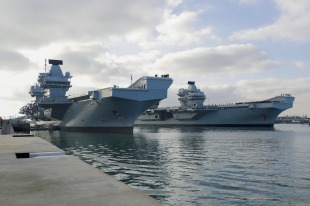
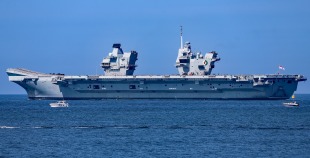
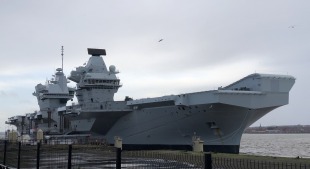



 Royal Navy
Royal Navy